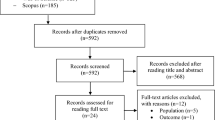Abstract
Background and purpose
Little data exists about longterm outcome, quality of life (QOL) and its predictors after spontaneous cervical artery dissections (sCAD).
Methods
Clinical and radiological data of 114 patients with sCAD were collected prospectively. Six patients died within 3 months, the remaining 108 were contacted after a mean of 1498 days (range: 379–3455), 99 survivors (92 %) replied. QOL, assessed with the stroke-specific QOL scale (SSQOL), and functional abilities, measured with modified Rankin Scale (mRS) were compared, and predictors of QOL were analyzed. Subgroup analyses were performed for patients with ischemic stroke, those with isolated local symptoms or transient ischemic symptoms and those without significant disabilities (mRS 0–1) at follow-up.
Results
Seventy-one of 99 patients (72 %) had no significant disability, but only 53 (54 %) reported a good QOL (SS-QOL ≥ 4). Compared to the self-rated premorbid QOL of all patients, SS-QOL was impaired after sCAD (p < 0.001); impairment of QOL was observed in patients with ischemic stroke (p < 0.001), in patients with isolated local or transient ischemic symptoms (p < 0.038) and those without significant disabilities at follow-up (p = 0.013). Nevertheless, low mRS was associated with better overall QOL (Kendall’s tau > 0.5). High National Institute of Health Stroke Scale score on admission and higher age were independent predictors of impaired QOL (p < 0.05).
Conclusion
QOL is impaired in almost half of long-term survivors after sCAD, even in patients with local or transient symptoms or without functional disability. Impairment of QOL is a surprisingly frequent long-term sequela after sCAD and deserves attention as an outcome measure in these patients.
Similar content being viewed by others
References
Leys D, Bandu L, Henon H, Mounier- Vehier F, Rondepierre P, Godefroy O (2002) Clinical outcome in 287 consecutive young adults (15 to 45 years) with ischemic stroke. Neurology 59:26–33
Biousse V, D’Anglejan-Chatillon J, Touboul PJ, Amarenco P, Bousser MG (1995) Time course of symptoms in extracranial carotid artery dissections. A series of 80 patients. Stroke 26:235–239
Arnold M, Cumurciuc R, Stapf C, Favrole P, Berthet K, Bousser MG (2006) Pain as the only symptom of cervical artery dissection. J Neurol Neurosurg Psychiatry 77:1021–1024
Arauz A, Hoyos L, Espinoza C, Cantu C, Barinagarrementeria F, Roman G (2006) Dissection of cervical arteries: long-term follow-up study of 130 consecutive cases. Cerebrovasc Dis 22:150–154
Lee VH, Brown RD, Mandrekar JN, Mokri B (2006) Incidence and outcome of cervical artery dissection: A population- based study. Neurology 67:1809–1812
Kasner SE, Hankins LL, Bratina P, Morgenstern LB (1997) Magnetic resonance angiography demonstrates vascular healing of carotid and vertebral artery dissections. Stroke 28:1993–1997
Auer A, Felber S, Schmidauer C, Waldenberger P, Aichner F (1998) Magnetic resonance angiographic and clinical features of extracranial vertebral artery dissection. J Neurol Neurosurg Psychiatry 64:474–481
Provenzale JM, Morgenlander JC, Gress D (1996) Spontaneous vertebral dissection: clinical, conventional angiographic, CT, and MRI findings. J Comput Assist Tomogr 20:185–193
Mokri B (1990) Traumatic and spontaneous extracranial internal carotid artery dissections. J Neurol 237:356–361
Baumgartner RW, Arnold M, Baumgartner I, Mosso M, Gonner F, Studer A, Schroth G, Schuknecht B, Sturzenegger M (2001) Carotid dissection with and without ischemic events. Neurology 57:827–832
Headache Classification Committee of the International Headache Society (1988) Classification and diagnostic criteria for headache disorders, cranial neuralgias and facial pain. Cephalalgia 8(Suppl 7):1–96
International Classification of Headache Disorders, 2nd edition (2004) Cephalalgia24(Suppl 1):1–160
Brott T, Adams HP Jr, Olinger CP, Marler JR, Barsan WG, Biller J, Spilker J, Holleran R, Eberle R, Hertzberg V, Roorick M, Moomaw CJ, Walker M (1989) Measurements of acute cerebral infarction: a clinical examination scale. Stroke 20:846–870
Williams LS, Weinberger M, Harris LE, Clark DO, Biller J (1999) Development of a Stroke-Specific Quality of Life Scale. Stroke 30:1362–1369
Van Swieten JC, Koudstaal PJ, Visser MC, Schouten HJ, van Gijn J (1988) Interobserver agreement for the assessment of handicap in stroke patients. Stroke 19:604–607
Merino JG, Lattimore SU, Warach S (2005) Telephone assessment of stroke outcome is reliable. Stroke 36:232–233
Fischer U, Anca D, Arnold M, Nedeltchev K, Kappeler L, Ballinari P, Schroth G, Mattle HP (2008) Quality of life in stroke survivors after local intraarterial thrombolysis. Cerebrovasc Dis 25(5):438–444
Bassetti C, Caruzzo A, Sturzenegger M, Tuncdogan E (1996) Recurrence of cervical artery dissection. A prospective study of 81 patients. Stroke 27:1804–1807
Leys D, Debette S (2006) Long-term outcome in patients with cervicalartery dissections: there is still a lot to know. Cerebrovasc Dis 22:215
Czechowsky D, Hill MD (2002) Neurological outcome and quality of life after stroke due to vertebral artery dissection. Cerebrovasc Dis 13:192–197
Arnold M, Bousser MG, Fahrni G, Fischer U, Georgiadis D, Gandjour J, Benninger D, Sturzenegger M, Mattle HP, Baumgartner RW (2006) Vertebral artery dissection. Presenting findings and predictors of outcome. Stroke 37:2499–2503
Dorman PJ, Waddell F, Slattery J, Dennis M, Sandercock P (1997) Are Proxy assessments of health status after stroke with the EuroQol questionnaire feasible, accurate, and unbiased? Stroke 28:1883–1887
Williams LS, Bakas T, Brizendine E, Plue L, Tu W, Hendrie H, Kroenke K (2006) How valid are family proxy assessments of stroke patients’ healthrelated quality of life? Stroke 37:2081–2085
Thomassen L, Waje-Andreassen U, Naess H, Elvik MK, Russell D (2005) Long-term effect of intravenous thrombolytic therapy in acute stroke: responder analysis versus uniform analysis of excellent outcome. Cerebrovasc Dis 20:470–474
Nedeltchev K, Fischer U, Arnold M, Ballinari P, Haefeli T, Kappeler L, Brekenfeld C, Remonda L, Schroth G, Heinrich PM (2006) Long-term effect of intraarterial thrombolysis in stroke. Stroke 37:3002–3007
Author information
Authors and Affiliations
Corresponding author
Rights and permissions
About this article
Cite this article
Fischer, U., Ledermann, I., Nedeltchev, K. et al. Quality of life in survivors after cervical artery dissection. J Neurol 256, 443–449 (2009). https://doi.org/10.1007/s00415-009-0112-2
Received:
Revised:
Accepted:
Published:
Issue Date:
DOI: https://doi.org/10.1007/s00415-009-0112-2




